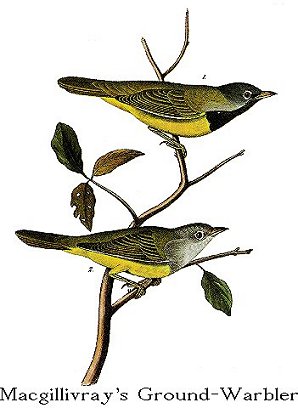
| Family VIII. SYLVICOLINAE. WOOD-WARBLERS. GENUS III. TRICHAS, Swains. GROUND-WARBLER. |
Next >> |

Family |
MACGILLIVRAY'S GROUND-WARBLER. [MacGillivray's Warbler (see also Mourning Ground-Warbler).] |
| Genus | TRICHAS MACGILLIVRAYI, Aud. [Oporornis tolmiei.] |
When I first saw the specimens of this bird, which had been transmitted by
Mr. TOWNSEND to the Academy of Natural Sciences of Philadelphia, I considered
them as identical with Sylvia Philadelphia of WILSON; but on subsequently
comparing them with a number of individuals of the latter species, procured by
my friend EDWARD HARRIS, Esq. in our Middle and Eastern Districts, I found
differences sufficient to indicate their being specifically distinct. In
consequence of which I have dedicated this pretty little bird to my excellent
friend WILLIAM MACGILLIVRAY, Esq. and feel much pleasure in introducing it to
the notice of the ornithological world, under a name which I trust will endure
as long as the species itself.
Mr. TOWNSEND, who found it on the banks of the Columbia, states that it is
mostly solitary and extremely wary, keeping chiefly in the most impenetrable
thickets, and gliding through them in a cautious and suspicious manner. It may,
however, sometimes be seen towards mid-day perched upon a dead twig over its
favourite places of concealment, and at such times warbles a very sprightly and
pleasant little song, raising its head until its bill is almost vertical,
swelling its throat in the manner of its relatives."
Mr. NUTTALL has also favoured me with the following interesting account of
it.--"This species is one of the most common summer residents of the woods and
plains of the Columbia, appearing early in May, and remaining until the approach
of winter. After the manner of the Maryland Yellow-throat, it keeps near the
ground in low bushes, where it gleans its subsistence. When surprised or
closely observed, it is shy and jealous, immediately skulking off, and sometimes
uttering a loud snapping clink. Its note has occasionally the hurried rattling
sound of Turdus aurocapillus, resembling t'tsh t'tsh ttsh tsheetee, alternately
into tsh tsh tsh teet shee. Another male, on the skirts of a thicket, called
out at short intervals vish vishtyu, changing to vit vit vit vityu and vit vit
vityu, sometimes, when approached, dropping his voice, and abbreviating his
song. Another had a call of visht visht, visht e visht t'shew, and visht visht
vishteshew or vititshee. On the 12th of June, a nest of this species was
brought to me, containing two young birds nearly quite fledged, in the garb of
the mother, pale yellow beneath, and brightish yellow-olive above. The nest was
chiefly made of stripes of the inner scaly bark of probably the white cedar,
Thuya occidentalis, lined with slender wiry stalks of dry weeds, and concealed
near the ground in the dead mossy limbs of a fallen oak, and further partly
hidden by a long tuft of usnea. It was less artificial than the nest of the
Yellow-throat, but of the same general appearance, and concealed in a similar
situation, probably in a thicket near the ground. On returning the nest to the
place it had been taken from, I had almost immediately the satisfaction of
seeing the anxious parents come to feed their charge, and for some days they
shewed great anxiety on being approached."
"This," says my friend Mr. HARRIS, "is the Warbler that so closely
resembles the S. Philadelphia. Mr. TOWNSEND has brought in more specimens,
which agree with the others in the very distinctive mark of the white eyelids,
with dark spots from the base of the bill to the eyes, and also dark on the
front at the root of the upper mandible. I cannot but think it entirely
distinct."
This species, as has already been observed, is very intimately allied in
form, proportions, colours, and habits with that described by Wilson under the
name of "Mourning Warbler, Sylvia Philadelphia." His account of the latter is
as follows:--"The bird from which the figure in the plate was taken, was shot in
the early part of June, on the border of a marsh, within a few miles of
Philadelphia. It was flitting from one low bush to another, very busy in search
of insects, and had a sprightly and pleasant warbling song, the novelty of which
first attracted my attention. I have traversed the same and many such places,
every spring and autumn since, in expectation of again meeting with some
individual of the species, but without success. I have, however, the
satisfaction to say, that the drawing was done with the greatest attention to
peculiarity of form, markings, and tint of plumage; and the figure on the plate
is a good resemblance to the original."
MACGILLIVRAY'S WARBLER, Sylvia Macgillivrayi, Aud. Orn. Biog., vol. v.p. 75.
Wings rather short, the second quill longest, the fourth longer than the
first, the tail long, considerably rounded, its feathers rounded; tarsus longer
than the middle toe and claw. Male olive-green above; the head, hind part, and
sides of the neck bluish-grey; the fore neck and part of the breast
greyish-black, lunulated with greyish-white; a black loral band; a conspicuous
white spot on each eyelid; the lower parts bright yellow. Female olive-green
above, yellow beneath, the sides of the neck and a band across the breast
ash-grey.
Male, 5 1/4, 6 1/2. Female, 5, wing 2 (4 1/2)/12.
Columbia river. Common.
| Next >> |